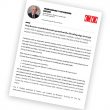Gregory North Miratech Digital Transformation Practice Lead, President at Globe North

About Globe North
Globe North provides executive advisory services for public, private and non-profit institutions. Our experience transforming organizations across many industries including Public Sector, Financial Services, Health Care, Wireless Communications and Defense Electronics provides a pathway to delivering better outcomes for customers at a lower cost to serve.
We don’t start a family vacation by getting in a car and driving, we start by deciding where we want to go and determining if we should drive, fly, or maybe take a cruise. We have a conversation about what kind of vacation we can afford and get input from the kids on where they would like to go. We then pull all this together into a plan with a clear destination, a way to get there and a price we are willing to pay for the experience. Unfortunately that is a lot more than can be said of many transformation programs. Too often they feel like a dream, or is it a nightmare, where we wake up on a plane headed we don’t know where,with no idea how we got on board. But it is clear we are flying first class, so this must have been a really expensive ticket. How does that happen? Why does survey after survey of CEO’s, CIO’s and COO’s report failure rates for transformation programs greater than 50%, often citing as reasons for failure unclear goals and not taking into account organizational and process complexity? Why do companies invest so much time, money and organizational mindshare on leaps in technology or changes to operating model without a well-defined roadmap? Perhaps the answer lies in three factors that in combination represent a perfect storm of pressures on leaders today:
- Need to constantly report and show improvement in results
- Very rapid rate of change in consumer and commercial ecosystems
- Ever increasing number of choices in technology enablement
Simply put – leaders today have much less time to think about much more with someone always watching.
Back to our vacation scenario. Imagine you and your family are on a globally televised game show where you have sixty seconds to cycle through all the possible options on where to go, how to get there and how much to spend while millions were watching. What is the chance that would go well? Welcome to the life of the CEO of a global business. Is it any surprise that these pressures result in decisions that later result in failure?
Still, the buzz today is all about transformation, usually digital transformation. Companies threatened by digital disruption and racing to keep up with rapidly changing consumer expectations know they need to transform if they are to survive – let alone thrive.
But transform to what?
And how?
Too often these questions get lost in the rush to get something you can call digital transformation going. They do come up later at the “lessons learned” session, when why the project went so wrong is the subject of the meeting.
Does your organization have a well-drawn transformation strategy and roadmap?
The first stepping in framing your roadmap is calling a transformation time-out – hold the calls, cancel daily updates on progress, go off site if needed.
The objective is to take a big, strategic step back, carving out time and mindshare to think systematically about this thing called transformation, gaining perspective on your current position, the competitive threats and new opportunities opened up by changes in technology and business model.
To get to a smart transformation roadmap there are things we need to recognize and questions we must answer.
- Transformation is a road to a future state that should be a strategically better position than the current state. This requires strategic clarity, honesty about gaps in current capability and specificity about future state elements.
- Choices about the vehicle we use to transform (people, process and/or technology) depend on how far we are from the desired destination, what conditions are like between here and there, how much we have available to invest, and how much time we have.
- Transformation is not something we do alone. Who needs to be on the journey with us – within our organization, across our network, and from the universe of possible partners and suppliers – depends on what plays we need the team to run.
- Timing is everything in transformation. Take the leap too early and the market is not ready, too late and there is no market left.
- Every transformation efforts faces obstacles and understanding those up front helps one plan and prepare for them.
- The considerations above are not independent variables. Having different partners may open up new possibilities about where we can go and how we can overcome obstacles in our path.
This all sounds so simple – take a strategic pause, ask and answer some questions, then off you go. But if it were that easy we would all already be doing it all the time. Our own experience and the data suggests otherwise. This should not be surprising as transformation is not about what technology can do, it’s about what humans can do with technology. It takes tremendous self-control to resist the latest tech shiny object until you know what it is for, courage and candor to admit that your strategy is not sufficiently clear or that your operating environment is overly complicated or that your capabilities are limited requiring a partner to provide insight or technology you lack. It takes design thinking to center the transformation on real customer needs and lean design to keep the business model and business process as simple as possible.
What if Sears had launched the online service Prodigy back in 1984 as the front door to its legendary core competency – catalog shopping and mail-order logistics, encouraging consumers to shop from home? Instead, Prodigy was positioned as a dial-up service like AOL, an easy to use front end to the entire internet. When that market did not pan out Sears sold its position in Prodigy after investing hundreds of millions of dollars. Conversely, Amazon.com was launched on an investment of less than one million dollars as just a website where you bought books online. That simple business model was the base from which the entire retail industry has been transformed. Strategic wrong turns are always easier to spot through the rearview mirror, but there is no question an alternative history of digital retail could have been written by Sears, its pioneering hero.
Clearly, the downside risk of mismanaging transformation is extreme – opportunity missed, resources squandered, even existential threats. So we had better take the time to get it right.
Transformation is a journey. You are going to need a roadmap.
To get started on your digital roadmap, learn more by going to www.globenorth.com.
More from Gregory:
Transformation Is a Journey – You’re Going to Need a Roadmap
Learn more







